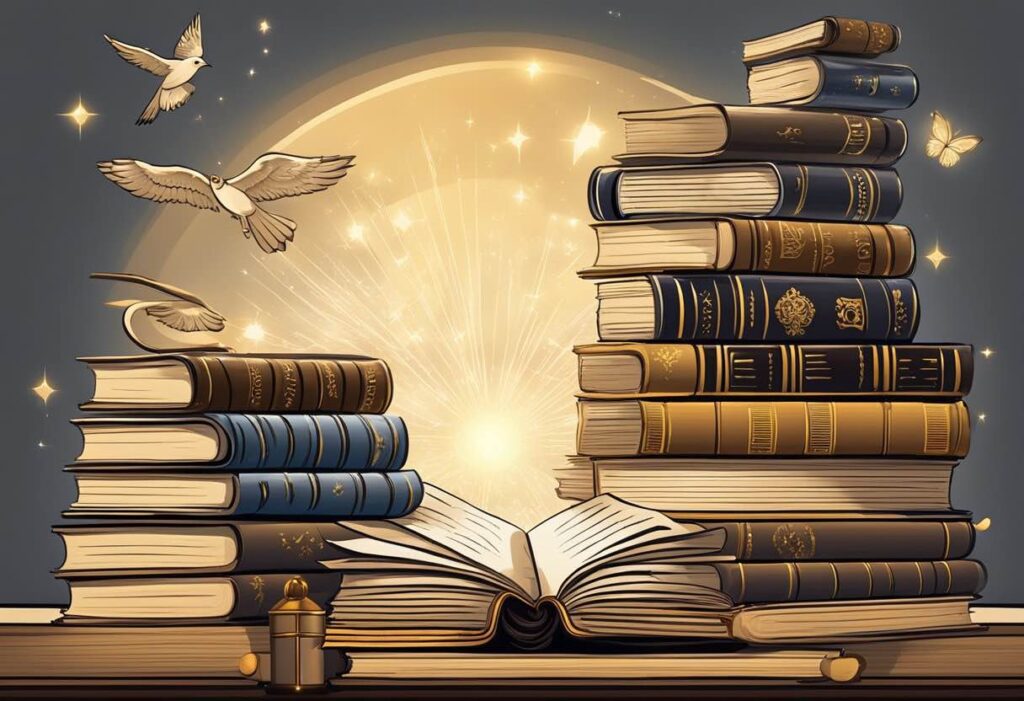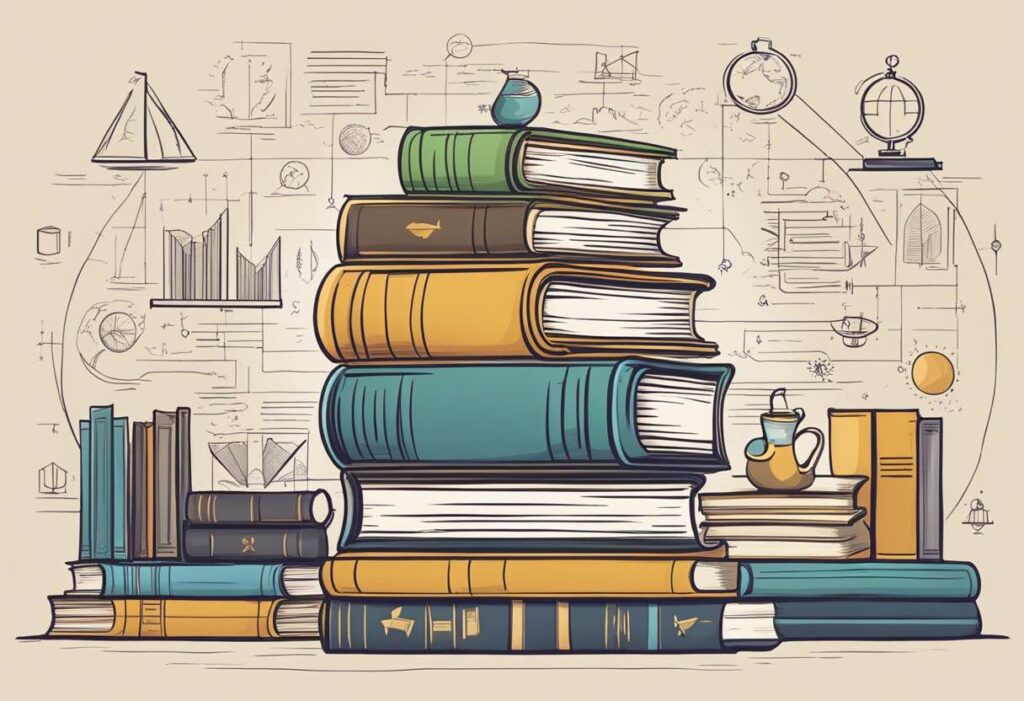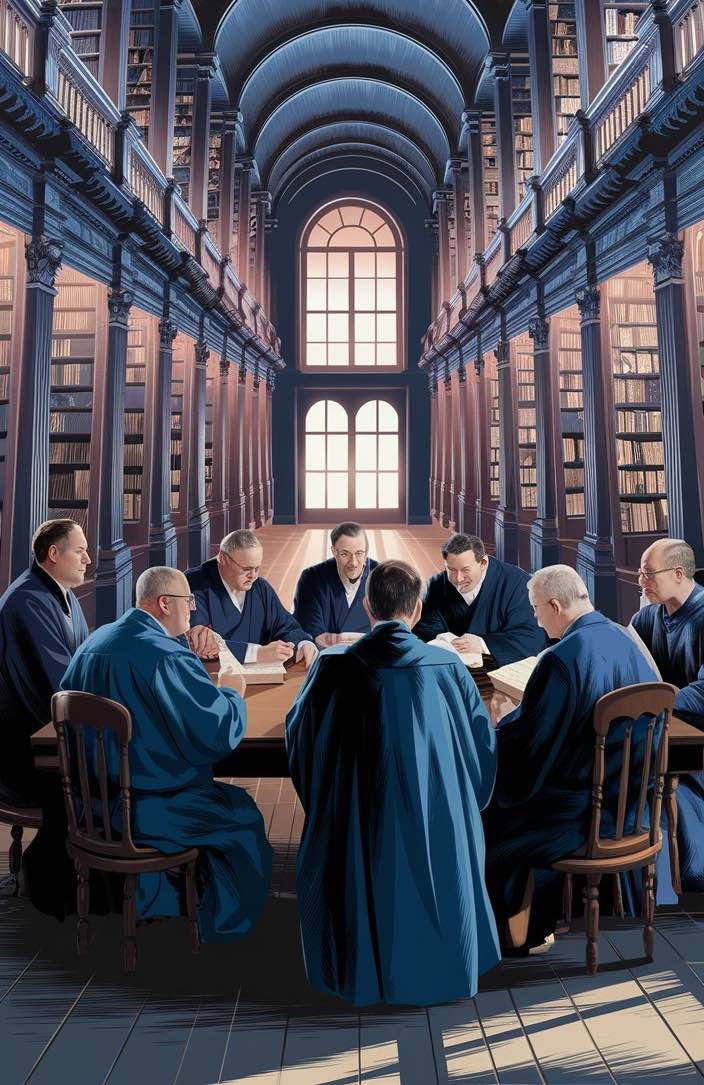- Literary theories provide essential frameworks for analyzing literature, enhancing readers’ understanding of texts beyond surface meanings.
- Key theories include:
– Classical Foundations: Originating with Plato and Aristotle, focusing on plot and character
– Enlightenment Expansion: Emphasizing reason and human experience
– Contemporary Perspectives: Including structuralism, poststructuralism, modernism, and postmodernism, which challenge traditional boundaries and interpretations - Critical approaches such as reader-response, psychological, social, feminist, and postcolonial criticism offer diverse lenses for interpretation, emphasizing the reader’s role and societal impacts.
- Methods of literary analysis include close reading, New Criticism, and biographical & historical analyses, which deepen comprehension of texts.
- Emerging trends like cultural studies and ecocriticism reflect evolving societal contexts, highlighting the interplay between literature, culture, and environmental consciousness.
- Engaging with these theories enriches the reading experience and fosters critical discussions about literature’s multifaceted nature.
Literary theories form the backbone of critical analysis, offering structured approaches to interpreting literature. These frameworks guide readers and critics alike in exploring texts beyond their surface meanings, allowing for deeper insights into their themes and contexts. Embracing literary theory enriches one’s engagement with texts, transforming reading into a more profound analytical exercise.
From classical theories like those of Plato and Aristotle to modern movements such as postmodernism and feminism, each theory presents unique lenses to examine texts. Whether prioritizing the role of the author, the text itself, or the reader’s experience, these perspectives invite diverse interpretations and foster critical discussions. By applying these varied approaches, readers gain the tools to decode complex literary elements and appreciate the multidimensional nature of literature.
Engaging with literary criticism not only enhances personal understanding but also broadens one’s appreciation of literature’s influence across cultures and time periods. These theories offer the tools to dissect language, structure, and meaning within a work, providing a comprehensive understanding of its artistic and cultural significance. Understanding the various critical perspectives empowers readers to form informed opinions and interact with texts more deeply.
Origins of Literary Theories
Literary theories have deep historical roots, evolving from early critical thoughts to more structured analyses. They draw from various cultural and philosophical traditions, impacting how literature is interpreted and understood today.
Classical Antiquity and Literary Criticism
In ancient Greece, literary theory originated with philosophers like Plato and Aristotle. Plato viewed literature with skepticism, believing it imitated reality and could mislead people. Aristotle, on the other hand, offered a more analytical approach. He emphasized the importance of plot and character in his seminal work, Poetics (circa 335 BCE), which remains influential. Aristotle’s focus on aesthetics introduced a systematic evaluation of artistic elements, setting a foundation for future criticism. His work marked a significant shift from mere philosophical speculation to a structured critique, laying early groundwork for the discipline of literary theory.
The Enlightenment and Critical Foundations
During the Enlightenment, literary criticism expanded with a focus on reason and empirical evidence. Thinkers of this period emphasized the importance of human experience in literature. They sought to establish clear principles of art, often drawing from previous classical methodologies. Figures like Nietzsche questioned traditional values and introduced ideas of aesthetic appreciation that challenged earlier conventions. This era set the stage for more diverse literary theories by fostering a critical environment that appreciated the reader’s role in interpreting texts. The Enlightenment provided a bridge between classical ideals and modern approaches, helping shape the critical foundations that support contemporary literary theories.
Contemporary Literary Theories
Contemporary literary theories explore diverse perspectives and methodologies in understanding literature, emphasizing the dynamic and evolving nature of interpretation. These theories often challenge traditional boundaries and suggest new frameworks for analyzing texts.
Structuralism and Semiotics
Structuralism emerged in the mid-20th century, focusing on the underlying structures that govern language and texts. Influenced by Saussure’s linguistic theories, it posits that elements within a text gain significance through their relationships with each other rather than intrinsic meanings. This approach seeks to uncover the universal structures shaping narratives.
Semiotics, a closely related field, scrutinizes signs and symbols in texts, taking into account the construction of meaning. Roland Barthes’ work often exemplifies this, highlighting how cultural contexts influence interpretation. Together, structuralism and semiotics offer a framework for deciphering complex layers within texts, emphasizing interconnectedness over isolated elements.
Poststructuralism and Deconstruction
Poststructuralism arises as a reaction to structuralism’s perceived shortcomings, suggesting that meanings are not fixed but fluid. Key figures like Jacques Derrida argue that language is inherently unstable, leading to multiple interpretations. Deconstruction, a method proposed by Derrida, involves deconstructing texts to expose assumptions and contradictions.
This approach emphasizes the play of meanings and challenges the notion of an authoritative interpretation. By questioning binary oppositions and traditional narratives, poststructuralism invites readers to explore the limitless possibilities of textual analysis. It underscores the complexities of meaning-making, encouraging an open-ended engagement with literature.
Modernism and Postmodernism
Modernism represents a departure from 19th-century conventions, seeking new forms to express the complexity of emerging 20th-century realities. Writers like Virginia Woolf and James Joyce experimented with narrative techniques, such as stream of consciousness, to capture fragmentary human experiences. Modernism emphasizes innovation and a break from tradition.
Postmodernism, evolving in the mid-to-late 20th century, further challenges conventions by embracing paradox, ambiguity, and playfulness. It often questions grand narratives and truth claims, suggesting that reality itself is subjective. Through techniques like pastiche and intertextuality, postmodernism reflects on the media-saturated and fragmented nature of contemporary life.
Critical Approaches to Literature

Examining literature through a variety of critical lenses allows for a deeper understanding of texts. This section focuses on reader-response criticism and psychological and psychoanalytic criticism, highlighting their unique perspectives on how literature can be interpreted and understood by readers.
Reader-Response and Reception
Reader-response criticism emphasizes the reader’s role in interpreting literature. Unlike traditional approaches that focus solely on the text itself, this perspective highlights how individual experiences, emotions, and imagination influence understanding. This perspective views readers as active participants who contribute their personal contexts to the reading process.
This approach asserts that the reader’s interaction with the text shapes the meaning, which is not static. Different readers may interpret the same work distinctly, reflecting diverse perspectives. Reception theory, a subset, examines how readers’ reactions change over time and across cultural contexts, showcasing literature’s evolving nature. This encourages acknowledging diverse interpretations and understanding literature as a collaborative experience between the text and its audience.
Psychological and Psychoanalytic Criticism
Psychological criticism delves into the mental states of characters and authors, providing insights into motivations and behaviors. Drawing from psychology, it explores how literature reflects the complexities of the human mind. Psychoanalytic criticism, particularly Freudian, analyzes texts for unconscious desires and anxieties, uncovering deeper meanings.
Psychoanalysis interprets symbolism in literature, revealing hidden landscapes of emotion and thought. In these analyses, Freudian concepts such as the Oedipus complex frequently surface. This lens not only deepens character analysis but also explores authors’ psychological backgrounds. Through these perspectives, literature becomes a window into psychological processes, creating a richer understanding of both character and creator. Reader engagement deepens as these approaches unravel the inner workings of texts and the minds behind them.
Social and Political Criticism
Social and political criticism in literature analyzes how written works engage with themes of power, inequality, and identity. It underscores the dynamics of class conflict, gender roles, and colonial legacies, offering a lens through which readers can understand and critique social structures.
Marxist Criticism
Marxist criticism examines literature through the lens of class relations and social conflict. It scrutinizes how texts depict the struggles between different social classes under capitalism. Karl Marx and Friedrich Engels laid the groundwork for this approach, emphasizing the importance of material conditions in shaping human experience.
Key Points:
- Class Conflict: Examines tensions between the bourgeoisie and proletariat.
- Economic Determinism: Focuses on how economic systems influence societal dynamics.
- Ideology Critique: Analyzes how literature can perpetuate or challenge capitalist ideologies.
By highlighting these aspects, Marxist criticism reveals the underlying economic forces and critiques the social hierarchies depicted in literature.
Feminist and Gender Criticism
Feminist and gender criticism explore how literature portrays gender roles and examines the influence of patriarchal structures. It critiques texts for reinforcing or challenging notions of gender identity and seeks to amplify voices marginalized by traditional gender norms.
Notable Figures:
- Virginia Woolf
- Simone de Beauvoir
- Julia Kristeva
Approaches:
- Gynocriticism: Focuses on women’s literary traditions.
- Anxiety of Authorship: Explores challenges faced by female authors.
- Ecofeminism: Connects ecological concerns with feminist issues.
These perspectives strive to uncover how literary works facilitate deeper understanding of gender dynamics and help question existing power structures.
Postcolonial Perspectives
Postcolonial criticism addresses the impact of colonialism on cultures and societies, as depicted in literature. It delves into themes of cultural identity, resistance, and power struggles resulting from European colonial rule.
Important Concepts:
- Cultural Identity: How colonized societies reassert their own voice.
- Hybridity: The blending of colonial and indigenous cultures.
- Resistance: Narratives that challenge colonial dominance.
Postcolonial theorists emphasize the ongoing effects of colonial legacies, as well as how literature can serve as both a historical record and a form of resistance against imperialist ideologies. These critiques aim to dismantle Eurocentric narratives and highlight the perspectives of historically marginalized communities.
Methods of Literary Analysis

Literary analysis employs various methods to explore texts, focusing on elements such as themes, structure, and context. Among the prominent approaches are close reading and New Criticism as well as biographical and historical analyses, each offering unique insights.
Close Reading and New Criticism
Close reading is a meticulous method that emphasizes a literary text’s careful, detailed interpretation. It involves examining the text’s language, structure, and meanings without external context. New Criticism, a movement aligned with close reading, prioritizes the text itself over the author’s biography or historical context.
By focusing on elements such as imagery, metaphor, and symbolism, practitioners aim to uncover layers of meaning within the work. The focus is on textual autonomy, implying that the significance of a text resides in its own language and form, unaffected by external influences. This approach encourages readers to engage deeply with the text, making intuitive and reasoned observations.
Biographical and Historical Analyses
Biographical analysis delves into the author’s life to enhance understanding of their work. It considers how the author’s experiences, beliefs, and personal history influence their writing. This approach bridges the connection between an author’s life and thematic elements within the text.
Historical analysis, on the other hand, situates a literary work within its historical period. Understanding the political, cultural, and social dynamics of the time enhances the appreciation of its themes and perspectives. This approach provides a more comprehensive understanding of how literature mirrors and molds the historical period in which it originated. Both approaches offer valuable lenses to interpret text by integrating the personal and historical context of its creation.
Literary Forms and Genres
Literary forms and genres provide structured frameworks for understanding a wide array of literary texts. These frameworks help categorize texts based on distinct features, enhancing comprehension of thematic and stylistic patterns.
Narrative Structure and Narratology
Narrative structure refers to a story’s organized framework. It often encompasses the sequence of events, the setting, characters, and the eventual resolution. A well-crafted narrative structure allows readers to follow the progression of the plot, making it essential for novels and other extended prose genres.
Narratology is a theoretical study of narratives. It examines how narratives are constructed and explores motifs that recur across literary works. Key elements of narratology include the role of the narrator, narrative voice, and point of view, each serving to shape the reader’s experience. By analyzing these aspects, narratology offers valuable insights into the underlying mechanics of storytelling.
Poetry and Dramatic Works
Poetry is a form of literature that emphasizes the aesthetic and rhythmic qualities of language. It uses meter, rhyme, and figurative language to evoke emotions and convey themes succinctly. Poetic forms vary widely, including sonnets, haikus, and free verse, each distinguished by unique structural characteristics. These forms often explore motifs such as love, nature, and human experience.
Dramatic works consist of plays and scripts intended for performance. These works depend heavily on dialogue and stage directions to express themes and develop characters. Unlike novels, dramatic texts are meant to be enacted, impacting how audiences perceive the narrative. Through dramatic elements like tension and conflict, these works illuminate the nature of human relationships and societal issues.
The Role of Critics and Theorists
Critics and theorists play a central role in shaping literary discourse. They provide frameworks that help in unraveling complex literary texts, offering various lenses through which readers can interpret these works. This section examines key figures and their contributions, as well as the practical methods employed in literary criticism.
Influential Literary Theorists
Mikhail Bakhtin is renowned for his dialogic approach to texts, emphasizing the importance of multiple voices and perspectives within any given work. His theories highlight the relational aspects of literature, allowing critics to explore intertextuality and the interaction between texts and contexts. Bakhtin’s ideas have greatly influenced areas like postcolonial and cultural studies, where dialogism serves as a tool to understand the plurality of voices in narratives.
The Johns Hopkins Guide to Literary Theory and Criticism (1994) is an essential resource that has documented a wide range of influential figures in literary theory. It includes theorists from different schools of thought, such as structuralism and deconstruction, with notable contributions from figures like Roland Barthes and Jacques Derrida. Their ideas facilitate a deeper examination of how narratives function by analyzing language, structure, and meaning.
The Practice of Criticism
Criticism involves analyzing, interpreting, and evaluating literature in various contexts. Practical criticism is a methodology developed in the early 20th century that encourages close reading and proficiency in analyzing the text itself without looking into external influences, such as historical context. This technique has been fundamental in teaching and appreciating literature, promoting a focus on literary devices, structure, and symbolism.
Critics employ theoretical frameworks to methodically dissect literary works, using structured analysis to draw insights. This involves evaluating themes, character development, and narrative style, offering a deeper comprehension of a text’s components. These methods aim not only to assess quality but also to uncover latent meanings that might not be immediately apparent to the casual reader.
Emerging Trends in Literary Theory
Literature continues to integrate diverse perspectives, leading to nuanced analyses that reflect changing societal contexts. Two key trends in contemporary literary theory include the incorporation of cultural studies and the increasing prominence of ecocriticism.
Cultural Studies and Criticism
Cultural studies in literary theory explore the relationship between literature and culture by emphasizing the power dynamics within texts. This approach draws on cultural theory to analyze how literature reflects and influences cultural identities and social structures. By examining literature through cultural lenses, critics can offer insights into themes of race, class, and gender.
Literature under this framework is not isolated but intertwined with cultural practices and beliefs. These analyses often reveal how texts challenge or uphold existing power relations, providing readers with a deeper value judgment on the prevailing cultural standards depicted.
Ecocriticism and Environmental Considerations
Ecocriticism has gained prominence as environmental concerns become increasingly pressing. This approach considers literature through the lens of ecological consciousness, highlighting the relationship between humans and the environment. It critiques texts that either foreground environmental degradation or celebrate natural harmony.
This theory encourages readers to reconsider traditional anthropocentric narratives, advocating for ecological awareness. It evaluates how literature engages with themes of sustainability and conservation, fostering discussions on literature’s role in shaping environmental values. As a result, ecocriticism serves as a catalyst for conversations about the ecological implications of human actions as depicted in literature.
Further Reading
Introduction to Modern Literary Theory by Dr. Kristi Siegel, kristisiegel.com
What Is Literary Theory and Why Do We Need It? by Alice Lopez, Salt Lake Community College
Why do we use literary theories in analysing of literary works? on Quora




